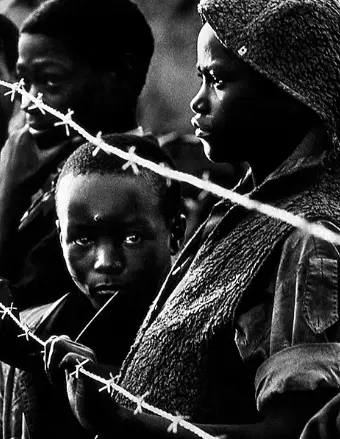A period of 100 days after the Belgian colonisation that put the two ethnic groups of Rwanda at conflict. Nearly one million Tutsi and moderate Hutu’s were killed while the UN peacekeepers stood by.
What's now Rwanda was an area where the Twas (the indigenous people), the Tutsis and the Hutus. During the Scramble for Africa they were colonised together by Germany, then later, Belgium. Belgium introduced identity cards separating people by ethnicity and they favoured the Tutsi minority, increasing pre-existing ethnic tensions. After Rwanda gained independence in 1962 the Hutus gained political power. Eventually the tensions exploded into civil war in 1990 when the RPF invaded. There were peace talks happening in 1993 with the Arusha Accords but the situation blew up when the President's plane was shot down on April 6, 1994 - pulling the trigger to the genocide.
The Genocide
The UN describe a genocide as a crime committed with the intent to destroy a national, ethnic, racial or religious group, in whole or in part.
The Rwandan Genocide was one of the most tragic modern genocides to occur. Spanning about 100 days from April to July of 1994, the genocide was planned and carried out by the extremist Hutus, including the government and a militia group known as the Interahamwe. They carried out the systematic mass murders up to 800, 000 Moderate Hutus, Tutsis, and Twas. During the 100 days of the genocide, an estimated 800,000 people were killed, that's an average over 8,000 deaths per day.


Social, Political and Economic Impacts

Social
- There were high tensions between the ethnic groups.
- Over 800,000 people were killed while communities were destroyed as neighbours turned on each other.
- There was widespread trauma among the survivors with fear still lingering around the corner.
- Prisoners with amnesty had trouble integrating back into the community.

Political
- The Hutu government was overthrown by the Rwandan Patriotic Front and they used aggressive tactics to limit opposition.
- Gacaca courts were created in order to address the vast number of cases.
- The failure of the international community to prevent or stop the genocide led to major changes in UN peacekeeping policy.
- It sparked the development of the "Responsibility to Protect" (R2P) doctrine, which ensure that the international community never again fails to halt the mass atrocity crimes of genocide, war crimes, ethnic cleansing and crimes against humanity

Economic
- Destruction of Infrastructure: Roads, schools, hospitals, and businesses were destroyed or abandoned,.
- Loss of Workforce: Over a million people were killed and millions displaced, leading to a massive loss of skilled labour.
- Collapse of Agriculture: The genocide disrupted food production, causing famine and economic decline.
- Increased Foreign Aid Dependence: Became heavily reliant on international aid for rebuilding its economy and public services.
RPF Victory
The RPF began to take over military control of Rwanda and faced surprisingly little opposition, except for in the capital of Rwanda, Kigali. However, in doing so, they killed many civilians in executions and massacres. The genocide eventually ended when the RPF took control of the government and the country on the 19th of July 1994, after around 100 days of blood shed.
ICTR
In order to address the momentous number of war crimes committed during the genocide, the UN created the ICTR (International Criminal Tribunal for Rwanda), in November of 1994. It was responsible for imprisoning those involved in the killings of the massacres and delivering justice.
Gacaca Courts
Locally, Rwanda established Gacaca courts to handle the vast number of lower-level cases, where they often publicly apologised for their crimes and was judged by their community.

United Nations' Involvement in the Resolution
The UN also played a significant part in ending the Rwandan Genocide by launching humanitarian missions and peacekeeping negotiations.
UNAMIR
The UN established the UNAMIR (United Nations Assistance Mission for Rwanda), deploying troops from countries such as Belgium, Bangladesh, Ghana, Tunisia and Australia. They and attempted to mediate peacekeeping attempts, which were unsuccessful. Countries began to pull out after 10 Belgium peacekeepers were killed in the assassination, by Hutu militants, of the Prime Minister, Agathe Uwilingiyimana, because she was a moderate Hutu.
Operation Turquoise
The UN then authorised French personnel to deploy their own soldiers and troops to launch a humanitarian mission in Rwanda, named ‘Operation Turquoise’. They set up ‘safe zones’ in various parts of Rwanda, saving the lives of countless civilians, but at the same time, allowing genocidaire soldiers, officials, perpetrators and militia men to flee the country.
The genocide ended with the RPF’s military victory. Although it brought peace, it was an enforced peace, not one that was negotiated. Many Hutus fled in fear to Zaire.
Furthermore, The ICTR and Gacaca courts brought accountability and set legal precedents, but justice was often seen as one-sided as crimes committed by the RPF went unchecked.
Regionally, the fallout caused major unrest. Armed groups in refugee camps triggered the Congo Wars, which killed millions. However, the genocide also inspired the Responsibility to Protect (R2P) doctrine, encouraging stronger international action to prevent future atrocities.
